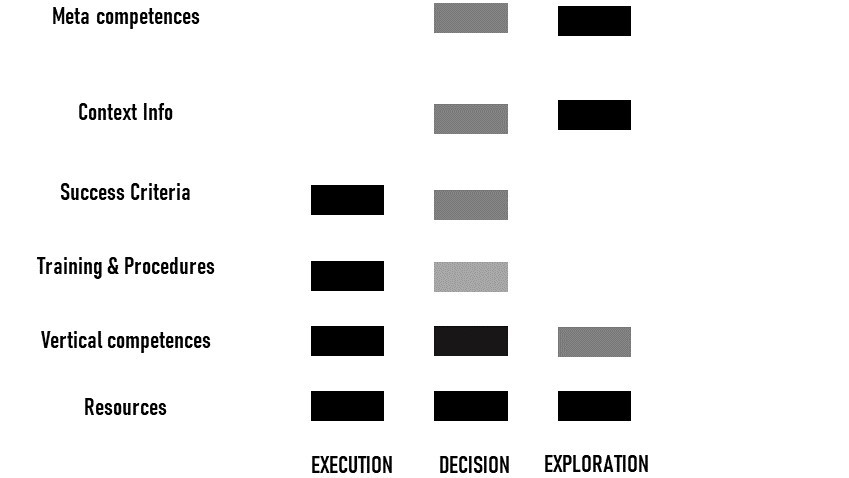
Self-Driving Team, Part Two
Article format this week, because the theme is broad and I would like to be sure I can provide all the Team players with the right information without having to compress the format too much.
Last week we introduced the topic, addressing the motivational aspects, i.e. why members of a #therightteam tend to prefer a high level of autonomy. Today, however, we treat the definition of “autonomous team” in a slightly more rigorous way and, in the style of #therightteam, we discuss some solutions and techniques to increase the level of autonomy of our team.
First of all, I would summarize the definition of “Autonomous”, classifying some subtypes that we often hear mentioned with @StefanoSusani in the “Vision” of Team Leaders or Team Players.
Executive teams with minimum supervision: they effectively carry out the tasks assigned to them requiring minimal intervention by the Leader who can thus focus on different aspects, for example related to people development, process improvement or external interface tasks. Many production teams fall into this category, creating their own “Value stream” in great autonomy, except for some special situations.
Self-decision-making teams: having received inputs and resources, they are able to carry out complex missions, solving any new problems they encounter gradually, often bringing a contribution of innovation which subsequently becomes common heritage (transactive memory, remember?). Surgical teams are a good example of this typology, mixing very strong vertical skills, well-defined procedures, combined with the ability to deal with relatively unexpected situations with creativity.
“Exploration” teams: they are units to which stakeholders entrust a very broad and often vague mission, which also includes the need to set their own objectives, to procure resources (or compete to secure them) and to develop systems and processes necessary to plot the course towards the final result. Teams that have to develop a new business for a company, as well as all innovation teams that have to solve a problem with innovative methodologies fall well into this subgroup.
This subdivision, deliberately a bit crude since teams rarely fall exclusively into one definition and they do so throughout their lives, helps us to examine some of the peculiarities to consider in setting up and organizing these teams. Because the answers to the needs of each subtype are very different.
Executive teams are process teams. Autonomy in these cases becomes synonymous with process stability. They must be provided by the leader with all the resources necessary to carry out their tasks (time, materials, tools, instructions) in order to be able to continuously achieve predictable outputs, the acceptability of which can be by the team itself or delegated to a third party stakeholder.
In the best version, they have the skills to analyze the efficiency of their process and to suggest improvements. This is the example of the Value Streams indicated in the Lean world, which meet on a daily basis to analyze the results of the previous session by analyzing problems and opportunities. The Team leader, as interface manager, must ensure clear and widely available resources, optimized procedures and transparent and inspectable acceptance criteria (Bridge with the Agile framework, here).
Also for the management of the unexpected it is necessary to adopt a pre-existing protocol, since these are not teams used to improvisation. In the Lean context we talk about the Andon process (from the Japanese “paper lantern”) which regulates the call for assistance from an operator to the team leader following a problem encountered.
The teams that have to make decisions independently are characterized by a mix of strong vertical-specialist skills (“Here everyone knows how to do their job very well”) and well-defined and well-known procedures (“Here we follow the protocol or someone dies”). At the same time, they possess some dynamic skills or meta-skills that allow them to deal autonomously with relatively unforeseen, partly hypothesized, partly completely surprising situations. For these reasons, their creation and maintenance is based on the training of skills such as adaptation and problem solving.
The Teams that I have defined as “Explorers” instead have very broad and often complex missions such as “Going to Mars” or, in a smaller scale, “Developing a product never seen before” or “Creating a new line of business”. To do this they will obviously be equipped with members with important vertical skills (they never hurt) but also with real masters of soft skills. This is because the system must work re in total autonomy, deciding not only how to achieve a goal, but often the goal itself. They navigate the ambiguity nonchalantly because those who commissioned the work cannot help them resolve the issues. However, here the real role of leadership, the ability of the stakeholders to provide the general context, the value scheme to comply with and above all the general rules of engagement to avoid excessive drifts will be of fundamental importance.
Finally, I tried to represent in a small diagram the fundamental quantities, the “knobs” that a Team Designer can use to be able to provide the type of team that wants to build the necessary ingredients in the right dosages.
